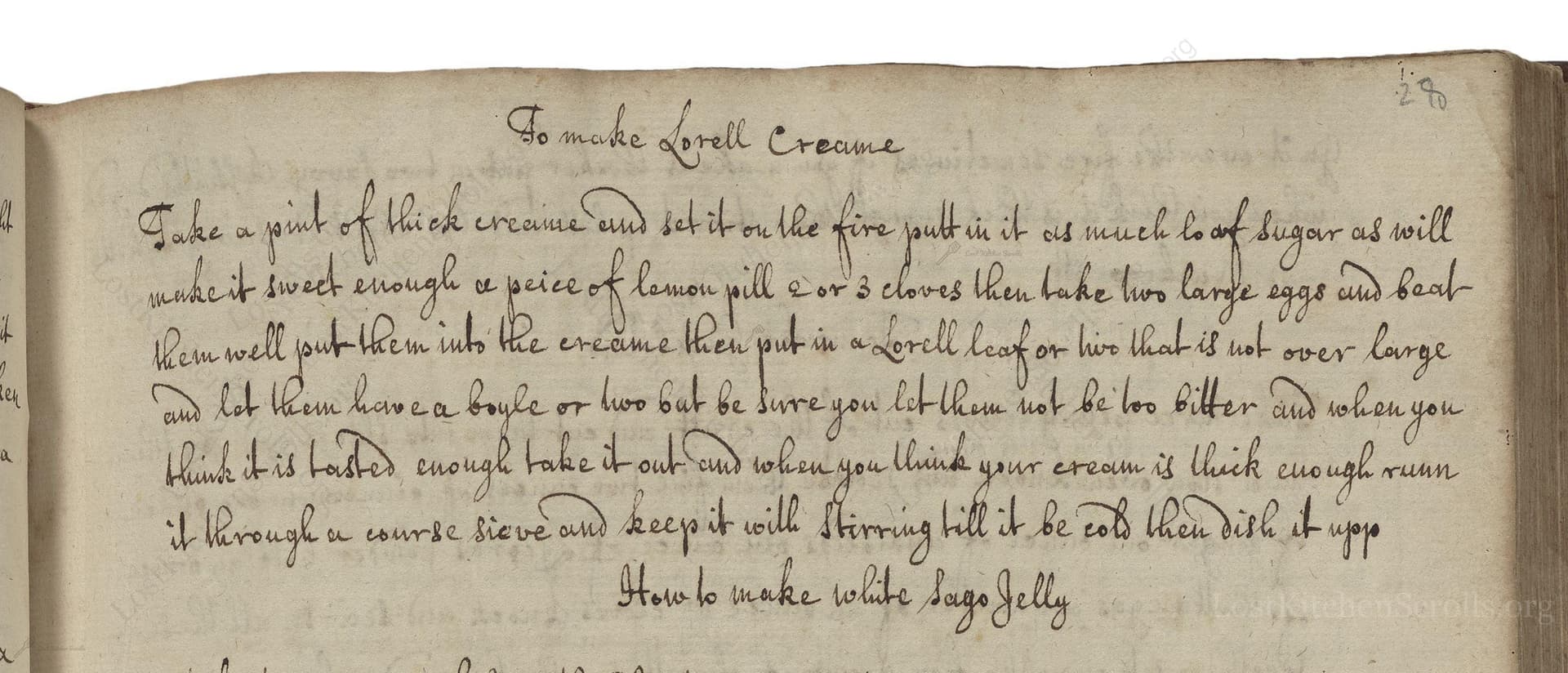To Make Sorell Creame
From the treasured pages of Mrs. Rachel Kirk Book 1707
Written by Rachel Kirk

To Make Sorell Creame
"Take a pint of thick creame and set it on the fire put in it as much loaf sugar as will make it sweet enough a peice of lemon pill 2 or 3 cloves then take two large eggs and beat them well put them into the creame then put in a sorell leaf or two that is not over large let them not be too bitter and when you think it is lasted enough take it out and when you think your cream is thick enough runn it through a course sieve and keep it with Stirring till it be cold then dish it upp"
Note on the Original Text
The recipe is written in continuous prose, without precise measurements or step-by-step instructions—common for the period, as cooks were expected to adapt to available ingredients and rely on culinary skill. Words like 'creame', 'pill' (for peel), and 'runn' (for strain) are examples of 18th-century English spelling. Quantities such as 'a sorell leaf or two' reflect the expectation that the cook will use taste and judgement, rather than fixed instructions.

Title
Mrs. Rachel Kirk Book 1707 (1707)
You can also click the book image above to peruse the original tome
Writer
Rachel Kirk
Era
1707
Publisher
Unknown
Background
A remarkable collection of early 18th-century recipes, Rachel Kirk's work invites readers into the kitchens of the past where classic culinary traditions and timeless flavors come alive. Expect a charming medley of savory feasts and sweet treats reflective of the era's sophisticated palate.
Kindly made available by
Folger Shakespeare Library
This recipe comes from the early 18th century, penned by Rachel Kirk in 1707. During this period, English housewives and gentlewomen compiled handwritten cookbooks not only of family favourites but also fashionable new tastes, especially custards and flavoured creams. Sorrel, a tart leafy green, was commonly grown in kitchen gardens and used to bring bright, citrusy notes to rich dairy dishes. Recipes like this reflect the era’s penchant for blending sweet, spicy, and sharp flavours in their desserts.

Cooks in the early 1700s would have used a heavy-bottomed pan or posset pot set over a gentle fire, a metal or wooden spoon for stirring, and a coarse sieve or strainer—perhaps even muslin cloth—for straining the finished cream. Beating was done with a fork or whisk made from thin branches or wire. Servings would be in shallow dishes or small bowls.
Prep Time
10 mins
Cook Time
20 mins
Servings
4
We've done our best to adapt this historical recipe for modern kitchens, but some details may still need refinement. We warmly welcome feedback from fellow cooks and culinary historians — your insights support the entire community!
Ingredients
- 1 pint (20 fl oz) double cream
- 2 to 2.75 oz caster sugar (adjust to taste)
- A strip of fresh lemon peel (about 2 inches long, yellow part only)
- 2-3 whole cloves
- 2 large eggs
- 1-2 fresh tender sorrel leaves (or substitute: 1 young spinach leaf plus a dash of lemon juice, if sorrel unavailable)
Instructions
- Begin by heating 1 pint (20 fl oz) of thick double cream gently in a saucepan.
- Add 2 to 2.75 oz caster sugar (to taste) to sweeten, a strip of fresh lemon peel, and 2-3 whole cloves.
- Separately, beat two large, fresh eggs thoroughly.
- When the cream is warm (not boiling), whisk in the eggs slowly.
- Add 1-2 young, tender sorrel leaves—taste as you go to avoid too much bitterness.
- Stir and cook the mixture on a gentle heat until the sorrel flavour is present and the cream has thickened to a custard-like consistency.
- Remove the lemon peel, cloves, and sorrel.
- Strain the mixture through a coarse sieve and stir it occasionally as it cools to prevent skin from forming.
- Serve when chilled.
Estimated Calories
400 per serving
Cooking Estimates
You need about 10 minutes to gather and prepare the ingredients, and 20 minutes to cook the custard gently until it thickens. Each serving contains about 400 calories, and this recipe makes 4 servings.
As noted above, we have made our best effort to translate and adapt this historical recipe for modern kitchens, taking into account ingredients nowadays, cooking techniques, measurements, and so on. However, historical recipes often contain assumptions that require interpretation.
We'd love for anyone to help improve these adaptations. Community contributions are highly welcome. If you have suggestions, corrections, or cooking tips based on your experience with this recipe, please share them below.
Join the Discussion
Rate This Recipe
Dietary Preference
Main Ingredients
Culinary Technique
Occasions

Den Bockfisch In Einer Fleisch Suppen Zu Kochen
This recipe hails from a German manuscript cookbook compiled in 1696, a time whe...

Die Grieß Nudlen Zumachen
This recipe comes from a rather mysterious manuscript cookbook, penned anonymous...

Ein Boudain
This recipe comes from an anonymous German-language manuscript cookbook from 169...

Ein Gesaltzen Citroni
This recipe, dating from 1696, comes from an extensive anonymous German cookbook...
Browse our complete collection of time-honored recipes



